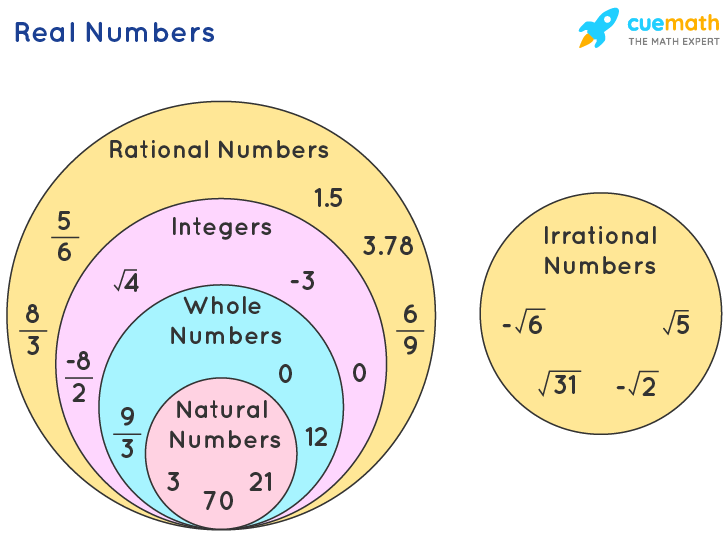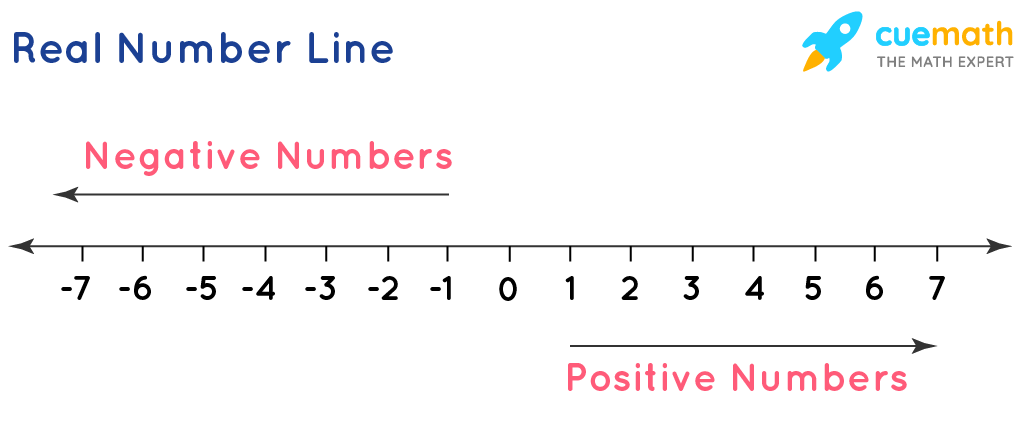Representation of Real Numbers on Number Line
Real numbers can be represented on a number line, which is a straight line that represents the integers in equal intervals. Both positive and negative integers can be represented on a number line in a sequence. This line extends indefinitely at both ends. Number lines represent real numbers i.e natural numbers, whole numbers, integers, rational numbers, and irrational numbers, and are used as a reference for comparing and ordering numbers.
Real Numbers Definition
The set of real numbers is the union of the set of rational numbers Q and the set of irrational numbers Q'. Therefore, all the numbers such as natural numbers, whole numbers, integers, rational numbers, and irrational numbers are subsets of the set of real numbers. The set of real numbers is represented by R.
R = Q + Q'

The table below represents the number set included in the set of real numbers.
| Number Set | Is it a part of the set of real numbers? |
|---|---|
| ✅ | |
| ✅ | |
| ✅ | |
| ✅ | |
| ✅ | |
| ❌ |
Real Number Line
Since we know that real numbers can be rational numbers or irrational numbers, every real number can be represented by a unique point on the number line. A real number line simply called a number line, represents real numbers with unique points associated with each number on the line. The point associated with real numbers is called a coordinate. In the number line, the number 0 is called the origin. All the positive numbers or integers are represented on the right side of the origin, and the negative numbers or integers are represented on the left side of the origin.
Here is an image that represents both the negative and positive numbers on a number line.

Steps to Represent Real Numbers on a Number Line
Real numbers can be represented on a number line with coordinates and graphs. Here are the steps to represent a real number on a number line:
- Step 1: Draw a horizontal line with arrows on both ends and mark off the number 0 anywhere. The number 0 is called the origin.
- Step 2: Mark real numbers in equal length on both sides of the origin and label them with a definite scale.
- Step 3: Positive numbers lie on the right side of the origin and the negative numbers lie on the left side of the origin.
- Step-4: Natural numbers, whole numbers, and integers can be marked easily by locating that particular point on the number line. If the given point is a large number let's say 100, we can change the number line scale accordingly. In this case, we can choose 1 unit as 20, so to mark 100, we just have to take 5 steps towards the right side of the origin.
- Step-5: Rational numbers and irrational numbers can be first converted to their decimal equivalents, and then we can mark them on the number line. Sometimes, it is not possible to mark a number on the exact point, so we have to consider the approximate decimal values of the numbers.
For example: Mark the real numbers - 5/2, 0, 3/2 and 2 on a number line.

Ordering of Real Numbers on a Number Line
The number line is also used in comparing real numbers. The larger numbers always lie to the right of the origin and the smaller numbers always lie to the left of the origin. We know that 19 is greater than 10 but when it comes to negative real numbers, the order is different. For example, -2 is greater than -6 since the negative numbers begin from the left of the origin. Once we graph each number on the number line it comes simpler to compare. Symbols like less than (<), greater than (>), and equal to (=) are used to compare the real numbers.
The below image represents the above example of comparing two real numbers with the help of a number line.

Opposite Real Numbers on a Number Line
In a number line, opposite real numbers are the equivalents of positives and negatives i.e the opposite of - 8 is 8. The numbers are graphed at the same distance from the origin but in opposite directions according to their signs. For example, the opposite of -8 is 8. Look at the image below for reference:

Absolute Value of a Real Numbers on a Number Line
The absolute value of a real number x that is written as |x|, is defined as the distance between the origin and the graph of that real number on the number line. Since it is a distance, it is always positive. For example: |-3| = 3 and |3| = 3. Look at the image below for reference:

Related Articles
Listed below are a few related topics to the representation of real numbers on a number line. Click to know more!
Solved Examples
-
Example 1: Is √2 a real number? What type of real number is it? Can you plot it on a number line?
Solution:
Yes, √2 is a real number. It is categorized as an irrational number. Let's locate √2 on a number line and name the vertices of the square as shown. Keep the vertex O at zero. By Pythagoras Theorem, OB = √2

Using a compass with center O and radius OB, draw an arc intersecting the number line at point P.

The point P corresponds to √2 on the number line. Therefore, point P shows the number √2 on the number line.
-
Example 2: Sam's teacher plotted the numbers 1/2 and 2/3 on the number line. She asked Sam to find and plot a rational number between these two numbers on the number line. Can you help Sam plot a rational number between them?
Solution:
We know that the midpoint of any two numbers lies between the two numbers.
Let's find the midpoint of the given two rational numbers.
(1/2 + 2/3)/2 = (3/6 + 4/6)/2 = (7/6)/2 = (7/6)/(2/1) = 7/6 × 1/2 = 7/12
This rational number 7/12 is shown on the following number line.

Therefore, The rational number is 7/12

FAQs on Representation of Real Numbers on a Number Line
How do you Classify Real Numbers?
Real numbers can be classified into two main categories - Rational Numbers and Irrational Numbers. Under rational numbers, these are the main concepts - integers, whole numbers, natural numbers, ratios, and terminating and repeating decimals. A few examples of rational numbers are -5, 9.6666..., 0, 11, 7.288. The concepts under irrational numbers are non-terminating and non-repeating decimals. A few examples are the square root of 8, square root of 3, pi, etc.
How do you Graph Real Numbers on a Number Line?
Real numbers can be represented on a number line with coordinates and graphs. Here are the steps to represent a real number on a number line:
- Step 1: Draw a horizontal line with arrows on both ends and mark off the number 0 anywhere. The number 0 is called the origin.
- Step 2: Mark real numbers in equal length on both sides of the origin and label them with a definite scale.
- Step 3: Positive numbers lie on the right side of the origin and the negative numbers lie on the left side of the origin.
Is Square Root a Real Number?
If the number inside the √ symbol is positive, then it is a real number. For example, √2 is a real number. If the number inside the √ symbol is negative, then it is not a real number. For example, √-2 is not a real number.
Is Pi a Real Number?
Yes, pi is a real number and can be represented approximately on a number line. It falls under the category of irrational numbers.
Does a Real Line and Number Line mean the same?
Yes, a number line is also called a real line as it is used to represent real numbers.
What is the Set of all Real Numbers?
The set of real numbers is a set containing all the rational and irrational numbers. It is represented by R.
Can we Represent all Real Numbers on a Number Line?
Yes, we can represent all real numbers on a number line. But, sometimes, mostly in the case of irrational numbers, we represent the approximate value of the number on the number line.
visual curriculum
